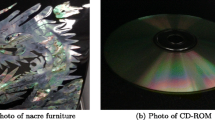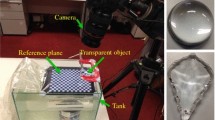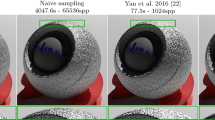Abstract
When light is scattered from mirror surfaces, complex optical effects occur, which are found in realistic scenes. They include caustics created by focused reflection, multiple refraction, and high-frequency glare from mirror-like microstructure. However, scenes containing mirror paths that involve chains of interactions with smooth metallic and refractive surfaces pose a significant challenge for visualization because, in this case, light paths are difficult to find. In other words, the probability of sampling an acceptable configuration that includes the camera and the light source is reduced. Caustics and rough surfaces with random patterns of glare due to their mirror microgeometry are visually striking examples of these mirror paths of light. There are many specialized methods capable of visualizing mirror paths of certain types with their own sets of constraints. However, none of the existing methods is suitable for the general case. For instance, photonic maps are a good solution for paths of certain types; however, they can cause undesirable blurring and are not applicable in some important cases, such as caustics on non-scattering surfaces or glare.
This paper presents a combined method for visualization of reflective and refractive caustics, as well as rough surfaces. Stochastic initialization and estimation of sample weight are used to find a solution for complex geometry. Two-pass stochastic initialization is used for rough surfaces with normal maps. At the first pass, the normal map is ignored and mirror paths are found on the original smooth surface. Normal perturbation is randomly selected from the distribution of normals present on the normal map. Gaussian approximation of the entire normal map obtained from the lowest level of the MIP map is used. The second pass, which starts with a rough surface, leads to a correct solution for complex geometry. Thus, the proposed method is extended to chains with rough surfaces and multiple interactions.
As a result, both direct and indirect caustics created by reflection from mirror surfaces are visualized. A more complex caustic scene that uses a non-Lambert reflection model, as well as a combined scene of caustic and rough surface, is also visualized. In the process of visualization, patterns on the rough metal surface are not blurred. The method also enables a very good representation of glossy, rough, and mirror-like materials. The results of visualization of highly realistic scenes are discussed.









Similar content being viewed by others
REFERENCES
Frolov, V.A., Voloboi, A.G., Ershov, S.V., and Galaktionov, V.A., State of the art of methods for global illumination calculation in problems of realistic computer graphics, Tr. Inst. Sist. Program. Ross. Akad. Nauk (Proc. Inst. Syst. Program. Russ. Acad. Sci.), 2021, vol. 33, no. 2, pp. 7–48. https://doi.org/10.15514/ISPRAS-2021-33(2)-1
Hachisuka, T., Ogaki, S., and Jensen, H.W., Progressive photon mapping, ACM Trans. Graphics, 2008, vol. 27, no. 5, pp. 1–8. https://doi.org/10.1145/1457515.1409083
Sik, M. and Krivanek, J., Implementing one-click caustics in corona renderer, Eurographics Symp. Rendering, Boubekeur, T. and Sen, P., Eds., 2019. https://doi.org/10.2312/sr.20191221
Hu, W., Dong, Z., Ihrke, I., Grosch, T., Yuan, G., and Seidel, H.-P., Interactive volume caustics in single-scattering media, Proc. ACM SIGGRAPH Symp. 3D Graphics and Games, 2010, pp. 109–117. https://doi.org/10.1145/1730804.1730822
Celestino, S., Romano, D., Laccetti, G., and Lapegna, M., Bidirectional path tracing: A rendering method with global illumination on GPU, Appl. Math. Sci., 2014, vol. 8, no. 133, pp. 6783–6790. https://doi.org/10.12988/ams.2014.49694
Jensen, H.W., Realistic Image Synthesis Using Photon Mapping, AK Peters/CRC Press, 2001.
Bagher, M.M., Soler, C., and Holzschuch, N., Accurate fitting of measured reflectances using a shifted gamma micro-facet distribution, Comput. Graphics Forum, 2012, vol. 31, no. 4, pp. 1509–1518. https://doi.org/10.1111/j.1467-8659.2012.03147.x
Löw, J., Kronander, J., Ynnerman, A., and Unger, J., BRDF models for accurate and efficient rendering of glossy surfaces, ACM Trans. Graphics, 2012, vol. 31, no. 1, pp. 1–14. https://doi.org/10.1145/2077341.2077350
Vyatkin, S.I., Complex surface modeling using perturbation functions, Optoelectron., Instrum., Data Process., 2007, vol. 43, no. 3, pp. 40–47.
Schlick, C., A customizable reflectance model for everyday rendering, Proc. 4th Eurographics Workshop Rendering, 1993, pp. 73–84.
Funding
This work was carried out in the framework of the state task, project no. 121041800012-8.
Author information
Authors and Affiliations
Corresponding authors
Ethics declarations
The authors declare that they have no conflicts of interest.
Additional information
Translated by Yu. Kornienko
Rights and permissions
About this article
Cite this article
Vyatkin, S.I., Dolgovesov, B.S. Highly Realistic Visualization of Caustics and Rough Surfaces. Program Comput Soft 48, 322–330 (2022). https://doi.org/10.1134/S0361768822050061
Received:
Revised:
Accepted:
Published:
Issue Date:
DOI: https://doi.org/10.1134/S0361768822050061




